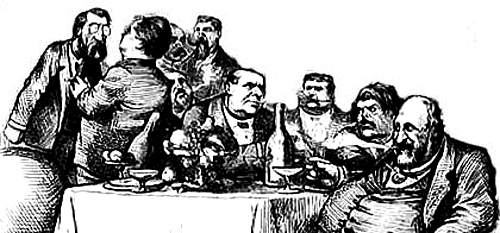Noted Cartoonists, Past and Present, Noted
Skip to commentsStan Mack, Darrin Bell, Bil Keane, Clare Victor Dwiggens, Garry B. Trudeau, Asher Perlman, and Justin Green.
Voices in The Village
Real Life Funnies, a strip by cartoonist Stan Mack, was a standing feature every week in The Village Voice from 1974 to 1995. Toting a sketchbook and pencils in a pouch on his belt, Mack — a pioneer of documentary cartooning — scoured New York City’s streets looking — and listening — for stories.
The Village Sun interviews Stan Mack on the occasion of the release of “Stan Mack’s Real Life Funnies: The Collected Conceits, Delusions, and Hijinks of New Yorkers from 1974 to 1995.”

Were Real Life Funnies political — in terms of your own views or those of the individuals you portrayed? Or did you see your work as really more apolitical reportage?
While my comics were rarely overtly political, they always seemed to favor the underdog over the “fat cat.” In the late ’80s, drawn to the squatter movement in the East Village, at a time when homelessness was rampant in the city, I did stories from the political and personal perspectives of: squatters, the homeless, the drug addled, the longtime political activists, and the self-proclaimed anarchists and revolutionaries as they battled the police in the cause of affordable housing. However, I never did miss an opportunity to make fun of the foibles of “the good guys.”
**********
A Prince of a Fellow at King
In 2003, Darrin introduced his comic strip Candorville, which was syndicated in newspapers by the Washington Post Writers Group (WPWG). By 2013, WPWG also began syndicating his editorial cartoons. In late 2018, Darrin transitioned his editorial cartoons to King Features Syndicate. When the Writers Group ceased syndicating comic strips, King Features also became the new home for Candorville.

Comics Kingdom turns its spotlight on Darrin Bell.
**********
Fellow Travelers: Bil Keane and Clare Victor Dwiggens.
Bil Keane’s popular newspaper comic The Family Circus was associated with an array of signature content, ranging from the adorable malapropisms of its child characters to the naughty antics of ghostly rascals ‘Not Me’ and ‘Ida Know.’ The Sunday instalment of the series featured their own distinctive subject matter: what became known as the ‘dotted-line drawings.’ These large-sized and extensively detailed compositions traced the pathway of one of The Family Circus youngsters – usually Billy but occasionally Jeffy – as they travelled through the house, around the yard, or across the neighbourhood to complete some task

Michelle Ann Abate turns her scholarly research on comics cartography following the wanderings of Billy with a detour into Keane predecessor Dwiggens’ Footprints in the Sand via Taylor & Francis Online.

Whether showcasing the peregrinations of Billy or Jeffy, Keane’s compositions contain an uncanny similarity to a newspaper comic series that appeared during the Depression era: Footprints on the Sands of Time, by Clare Victor Dwiggins. The links between this 1930s series and The Family Circus reveal an influential but unacknowledged source of inspiration on Bil Keane and his work. At the same time, recognising and exploring the suggestive echoes that his dotted-line drawings have to Footprints on the Sands of Time add an element of historical complexity to this beloved feature of The Family Circus and to the newspaper comic series as a whole.
**********
When a Comic Strip Won The Pulitzer
Though it might not have the universal appeal of Peanuts, or have become a worldwide phenomenon like Garfield, Doonesbury deserves to be recognized among America’s most influential comic strips. Notably, Doonesbury was the first syndicated newspaper comic strip to win a Pulitzer Prize, making it a culturally and artistically relevant piece of pop culture to study to this day.
In 1975, Garry Trudeau’s Doonesbury won the Pulitzer Prize for Editorial Cartooning. It was the first time the award was given to a recurring comic strip – rather than a one-shot, one-page cartoon – since the award category came into existence in 1922.

Marcel Green at ScreenRant returns us to the Watergate era and Doonesbury and controversy.
Garry Trudeau came of age in one of the most politically dynamic times in contemporary American history; as a result, his opinion was shaped by the turbulent social atmosphere he grew up in. Doonesbury became an ongoing expression of his thoughts and feelings about the world around him. Trudeau had no qualms with placing these opinions about war, politics, and society in Doonesbury, and whether readers agreed or disagreed with various characters on various subjects, it was incredibly valuable to have them distilled into comic strip form.
**********
Cartoonist’s Most Inspiring Spots in NYC
Asher Perlman needs a lot of jokes. And as a writer for The Late Show with Stephen Colbert and a prolific New Yorker cartoonist with a hilarious new book, Well, This Is Me, he seems to have no shortage of material. Here, he reveals his top five spots to go when he needs, as he puts it, “a creative jumpstart.”

Asher Perlman tells Town and Country magazine where to go … for relaxation and revelations.
**********
A Primer for Underground Cartoonists Wannabes
In 1972, underground cartoonists began creating a slew of what were called “pouch epics”, They would take a standard 8 1/2″ x 11″ piece of paper and draw four panels on each side, then print or photo-copy it, fold, trim and staple it into a small, 8-page comic and sell them for “a mere 7-cents”.
Justin “Jud” Greene (July 25, 1945 – April 23, 2022) was … one of the first to create one of these miniature masterpieces.


John at World of Monsters presents Justin Green’s entire eight page mini-comic.


Comments 2
Comments are closed.